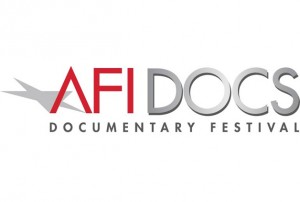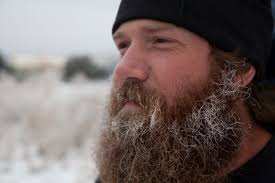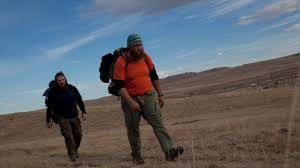A Conversation With Michael Collins (ALMOST SUNRISE)
 I met with director Michael Collins at the 2016 AFIDOCS on Wednesday, June 22, 2016, to discuss his new documentary feature Almost Sunrise, which tells the quietly profound tale of two Iraq War veterans who walk across the country as therapy for their PTSD. Here is a condensed digest of that conversation.
I met with director Michael Collins at the 2016 AFIDOCS on Wednesday, June 22, 2016, to discuss his new documentary feature Almost Sunrise, which tells the quietly profound tale of two Iraq War veterans who walk across the country as therapy for their PTSD. Here is a condensed digest of that conversation.
Hammer to Nail: How did you come upon the idea for the film? I read in the press notes that you first heard about the alarming statistic of 22 suicides per day for U.S. veterans while working on another video project. Could you talk about how you came upon the particular subject that you profile in your film?
Michael Collins: I was doing some volunteer work for an NGO – a vets organization – and I was flying around the country, interviewing vets, because I was making a promotional video for them, and I can remember the moment…I was in Fargo, and there was a Vietnam vet sitting across from me and just talking very casually and he just sort of said, 22 vets kill themselves every day. And I just said, I’m sorry, what? I was sure I had heard it wrong. He said, yeah, every day. He said it like I was supposed to know. And I think that, for me, was a little jolt to my system. It was shocking.
I was flying around the country meeting different vets, over the course of a week, and everything that they were saying to me just opened my eyes so much to everything that I didn’t know about what was going on with this community and how much they dealing with, and struggling with, on their own. I felt that separation between the “civilian population” and the veteran population, but I also knew, in listening to all these stories, that if other people had the same opportunity to hear their stories as I did, they would want to get involved. They would want to do something.
HtN: Do you have a military background, or does anyone in your family have a military background?
MC: I don’t. My grandfathers – both of them – were in the military. One of them, I never met. He was in World War I. He was actually from Italy. My other grandfather was actually a war hero in World War II: he was the lead bombardier flying over Germany. But he died when I was in high school.
HtN: So you get this idea about 22 suicides a day. How do you then meet [main subjects] Tom Voss and Anthony Anderson? How do you get from there to these guys?
MC: The interesting thing is, as I was doing this – interviewing vets, traveling around the country – Anthony was one of the vets that I interviewed. I was interviewing certain vets who had gone through a certain program called the “Power Breath Workshop” which is part of “Project Welcome Home Troops.” They’re here in DC. Anthony had been through that program, and he just happened to be one of the vets that I interviewed. So I just decided, OK, I want to make this film.
Months passed. I had just finished my last film [Give Up Tomorrow], and I went and traveled to India for a few months to kind of take a break, since I’d been on a film project for 8 years. And then I came back, and I was determined to find a way to tell that story, and I came across Anthony and Tom on Indiegogo, trying to raise money for this trek that they were going to do across the country. I said, I know that guy, and they’re walking across the country. This could be a film. Because I didn’t want to make, you know, an essay film. I didn’t want to make it just a talking-heads film about this issue. I wanted to make it character-driven. I really believe that you should connect with people on a heart level – that same experience I had talking to vets – and the only way to do that is to really immerse yourself in some individuals and their stories. So I reached out to Anthony, I said, hey, you remember me? About six months ago, I came and interviewed you. I’d love to follow you guys. Can I come to Milwaukee, meet you, and we’ll talk about it? My producer and I went out there, we spent about five days with them. They really interviewed us a lot more than we were kind of interviewing them, and we just felt like it was a great fit.
HtN: It’s interesting that you only met them after they had already planned the walk, because in your film, the way you’ve structured it, editorially, it feels as if you’ve been with them since long before they made that decision. Particularly the way you’ve set up the reveal of Tom’s depressive state, it’s very well done to make us feel like we’re there from the beginning.
MC: Oh, good. Thank you. I mean, we started shooting very quickly and the walk was only weeks away, at that point.
HtN: Well, again, it feels much earlier. So, at what point did you decide to include Tom’s girlfriend, Katinka Hooyer, as not just a supporting character, but as an expert in PTSD as well?
MC: That was really just like grace, you know, that we had someone who was an emotional character – who had this emotional investment in the story, itself – but also was an expert. Because we wanted to talk about the bigger-picture issues. So that was really just a gift to me, that she just so happened to be an expert in that. So it didn’t take that much to realize that we were going to have her wear two hats in the film. I understand that it’s a little complicated, because then she gets more screen time, and people have to see her in two different lights. Editorially, we struggled with it a bit, but it was kind of a no-brainer, for us. We interviewed VA doctors, and all these other people, but it didn’t feel organic to the story to bring in these outside voices.
HtN: Well, I think it works. Yes, she’s wearing those two hats, but she’s so articulate and smart. She’s a compelling character, so more of her is not a problem.
MC: That’s the way that I felt, too. I felt like anytime she came on, it was just such a gift.
HtN: And Tom’s a very lucky man, to have her in his life.
MC: Yes.
HtN: So I want to talk about the production. This solo hike turned into, first, a two-person hike, and then suddenly it turned into a two-person hike…with a camera crew following them. How much of the time that they were walking were you with them, and how much were they on their own?
MC: I was very conscious of the experience that they wanted to have, so I didn’t want to be with them the whole time. I really wanted to spend more time away than with them, so that they could actually have the experience, and then we could come back in and witness it. Because I knew that having a minivan essentially driving next to you for the whole walk would affect the experience. So…luckily we didn’t have a whole lot of money…(laughs)…so we could really only come for one week, or ten days, at a time, and then I would have to go home, for two or three weeks.
We tried to be strategic about when we would come back in. They were covering every landscape in the U.S. – which was amazing – and the U.S. itself is a character in the film, so we wanted to make sure that we covered all that, and all the different seasons, but we also wanted to make sure that we had enough time away from them so that they could have the experience. And we would talk to them, and if they knew that so-and-so in Colorado had been reaching out to them on Facebook for months and they knew that they were going to stay with them, then I knew that there was an opportunity there to have some more characters, and I would make sure that we would be there. Like, for Thanksgiving, or for Christmas…we made sure we were with them for any big milestone moments, but for the most part it was really just us planning the next shoot once we finished the shoot we were on. It was a gamble. We missed a lot of really good stuff.
HtN: Well, I think that’s inevitable, in a documentary, unless you’re filming 24/7. But I think you did a good job in capturing a variety of footage. So, there was stuff you didn’t film for logistical reasons. Were there any moments where you were not allowed to film, or just decided not to, consciously, for reasons of privacy? It’s always a challenge, in a documentary, because you want the best story…
MC: You know, there were a lot of sensitive moments. I think the most difficult thing, for me, was actually filming at the funeral [of Marine Lance Corporal Jeremiah M. Collins]. When I was with them [Anthony and Tom], the story of Shannon Collins [Jeremiah’s mother] came up on the television, and she’s from Milwaukee, and I was going to Milwaukee the next day, so…reaching out to her…for me, as a filmmaker, navigating that…how do I approach someone whose son just died ten days before? But I saw that she was on the news, so she was reaching out to the media…
So, going through that process, getting the permission to come in and film, knowing when we should film, what’s too much. Part of it is just showing the reality of war. And having her blessing…When I interviewed her, she said, one of things that I’m really upset about is that you’re not seeing these caskets coming home. So this is reality, this part of war. You know, we celebrate them when they go, when they’re these heroes, she said, but some of them don’t come home. This is also another side of war. So making that decision to film…an open casket!…was a tough one, but I think it’s a really intimate look at one of the aspects of what it means to send people to war.
HtN: Yes, I think it’s important. So, speaking of filming, your cinematographer [Clarissa de los Reyes] did a wonderful job. It’s beautifully photographed. Had you worked with her before?
MC: She was a friend. Actually, my last film was set in the Philippines, and she’s Filipina, so through that community and that connection we became friends. She lives in New York. I hadn’t worked with her before. I had seen her work, which is all beautiful, but for me, so much of it is about a personal relationship, because I knew we were going to be out there, moving, we were going to be in uncomfortable situations, working long hours, and she was very professional and easy to get along with. So she’s extremely talented behind the camera, but also a wonderful person to be with, so she was the whole package.
And then I was really lucky that Gideon de Villiers came on as sort of our second camera – our second unit DP [Director of Photography] – and he was also really talented. A younger guy, who would get up before the sun and say, we need to go get a sunrise, of them waking up, in the desert, which is two hours from where we’re staying. He did so much of the heavy lifting, and always with a smile. I had two really amazing cinematographers.
HtN: Tell me about the “Impact Campaign.” How do you see that playing out? What is your personal commitment?
MC: For me, the film was inspired from a place of activism, of wanting to make change. So I see the film as really a tool in a bigger project, as one element in a campaign that I am committed to for the next two years. Now that we have the film done, I’ve been in the “Impact Lab” here at AFIDOCS for the past two days – I literally just finished right before this interview – and we want this media to become a tool for other organizations out there that are trying to shine a spotlight on issues that veterans and their families are facing.
A lot of the film, as you know, is about mental health issues and more holistic approaches to healing, and community support, and bridging that perceived divide between the military and the civilian population. So we’re just looking for every which way that we can use this film as a tool to further along all of those missions. And some of it we’re going to get behind, ourselves, and do a really robust community-screening tour, and we’re now talking with the VA in New York about working in all of the schools with them. It’s really organic. These festivals are really where I invite the partners to come and they see the film and they experience the power of it, themselves, and then we say, OK, now how can we work together to get this film out there and to help further your mission.
We’re not trying to reinvent the wheel; we’re really just trying to partner with organizations like Stop Soldier Suicide, or a partner of ours in New York at Human Rights Watch, or Project Welcome Home Troops here in DC. The VA has a program called VITAL, which tries to help vets stay in school, since they have very specific issues that they’re facing. So we’re just trying to do as much as we can.
HtN: Well, it’s a great effort. Congratulations on the film, and good luck with the campaign!
MC: Thanks so much!
– Christopher Llewellyn Reed (@ChrisReedFilm)












